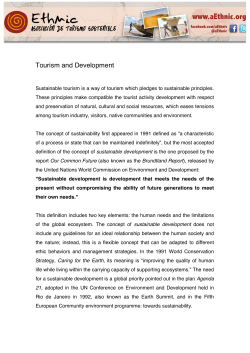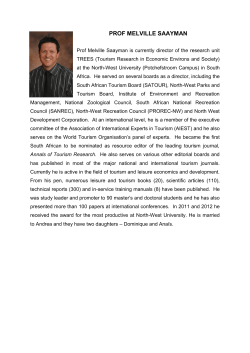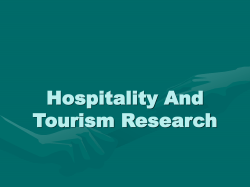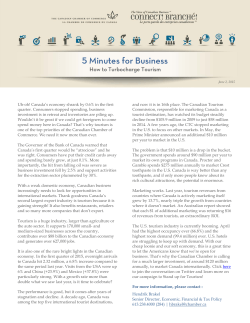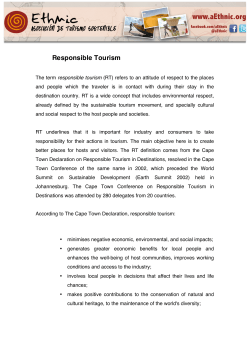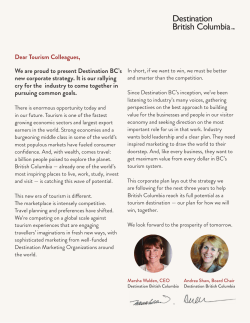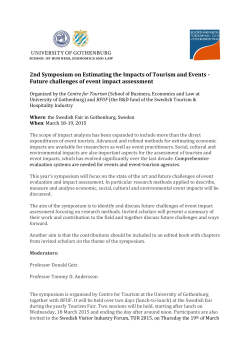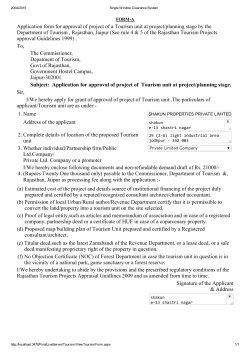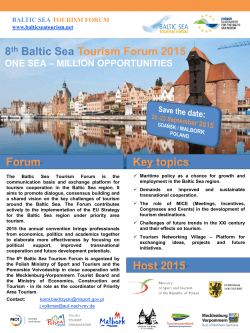
PG Diploma in Tourism Management.
SYALLABUS FOR PGDTM (For Academic Session : 2009) DIRECTORATE OF DISTANCE EDUCATION University of Kashmir. Hazratbal, Srinagar-190006 1 DIRECTORATE OF DISTANCE EDUCATION THE UNIVERSITY OF KASHMIR POST GRADUAE DIPLOMA IN TOURISM MANAGEMENT Course Structure & Scheme of Examination (Effective from session 2005) I. The following shall be the course structure for one year Post Graduate Diploma in Tourism Management: Course No. Title of the Course Distribution of Marks Semester Examination DTM-101 Tourism Development and Internal Total Assessment 80 20 100 Management DTM-102 Human Marketing 80 20 100 DTM-103 Human Resource Management 80 20 100 DTM-104 Management and Organizational 80 20 100 20 100 Behaviour DTM-105 Accounting for Managers 80 DTM-106 Information Management 80 II. IV. V. VI. 100 Each paper shall contain 100 marks with the following break up: - III. 20 Theory Internal Assessment 80 Marks 20 Marks Each paper shall contain 5 units. The question paper shall contain 10 questions, two from each unit. Students shall be required to attempt 05 questions selecting one form each unit within a period of 3 hours. The internal assessment marks shall be awarded by the counselor(s) of the respective courses on the basis of performance of the candidate in the test / assignments / case studies, etc. The examination shall be conducted after the completion of one academic year by the Controller of examinations. The programme administration shall be as per the procedure / guidelines adopted by Directorate of Distance Education for other programmes. 2 DTM-101: TOURISM DEVELOPMENT AND MANGEMENT Maximum Marks External Exam. Internal Assessment 100 80 20 Objective: This course aims at developing an insight among the students into the nature, significance , organization and development of tourism. The students will also understand the classification and grading systems in tourism operations and know the range of tourist attractions available to tourist. Unit - I Concept nature and Scope of Tourism; Historical development of tourism; Tourism as an operations system; Tourism as Service industry ; Dimensions of the tourism phenomenon; Tourism industry environment; Tourism demand and supply ; Concepts and management. Unit-II Structure and organization of Tourism trade; Structure and infrastructure; Tourism industry and Tourism categories ; Type of Tourism ; Dimensions of the tourism phenomenon; Tourism industry environment; tourism demand and supply; concepts and management. Unit-III Socio-cultural impact of tourism-Influence on the host culture, mixed cultures; Economic impact of Tourism; Tourism revenue, economic benefits, employment and tourism, investment in tourism; Tourism and national development; Environmental impact; Threats to the Environment, Unit-IV Tourism Planning and Development; Location of Tourism resources; factors affecting tourism planning ; Sustainable tourism planning and principles; Role of Government, Non government, private and international organizations in tourism development; effects of Flora and fauna on tourism development; Unit-V International tourism trends; Green tourism, eco-tourism; contribution of Tourism towards world peace; Major influences on the growth of international tourism; Globalization and tourism; tourism and migration; planning for mass tourism destination; Rural and urban tourism; Significance of information Technology in tourism development. Suggested Readings 1. 2. 3. 4. 5. 6. Holloway, J. Christopher. The Business of Tourism (Pitman Publisher, 1993) Cooper, C. Gilbert, D. & Wanhill S. Tourism Principles and Practice (Pitman Publishers 1993) Davidson, R. Business Travel (Pitman Publishing 1994) Burkat and Medlik, “ The management of Tourism (Heinemann) Lars Aronsson The Development of Sustainable Tourism (Continuum) Swarbrooke, J. The Development & Management of Visitor Attractions (Butterworth Heinmann 1995) INSTRUCTINS FOR PAPER SETTER The question paper shall contain ten questions, two questions from each unit. Candidates would be required to attempt 5 questions in all, selecting not more than one question from each unit in 3 hours duration. 3 DTM-102: TOURISM MARKETING Maximum Marks External Exam. Internal Assessment 100 80 20 Objective: This course aims at familiarizing the students with the changing marketing conditions; industry structure and to develop the marketing strategies to achieve excellence in tourism sector. Unit-I Tourism Marketing-Concept, Approaches, Relevance and Role. Modern Marketing and Tourism; Changing Business Environment; Aspects of Demand for Tourism; Managing Demand; Market Segmentation Approaches and variables, Tourism markets- International and Domestic. Unit-II Organization for Marketing –Role of Marketing Managers; Marketing Research-Concept scope and procedure; Sources of information; Designing a market research; planning market operations and campaigns; Competitive Analysis and strategies. Unit-III Marketing Mix in Tourism-Product, pricing , promotion and distribution strategies; People, process and physical evidence; Forecasting for tourism and its product, Role of technology in tourism marketing. Unit-IV Advertising and sales promotion in tourism; seasonal marketing; tourism fairs and travel markets. Destination marketing- leisure spots, events, activities, shopping, education and culture; Adventure Tourism ; Marketing of local foods. Unit-V Accommodation marketing star hotels and supplementary accommodation; Transport and travel service marketing –Airlines marketing tourist transport marketing travel agency marketing tourist operators marketing. Suggested Readings 1. 2. 3. 4. 5. VTC Middleton : Marketing in Travel & Tourism (Butterwort/ Heinemann) S Medlik ; Managing Tourism (Butterworth/ Heinemann) Event Marketing; How to Successfully Promote events, Festivals, Conventions and Holey Wily Expositions, event Management Series. Philip Kotler; Marketing Management, Prentice Hall of India Holloway, J. Christopher. The Business of Tourism (pitman Publishers 1994) INSTRUCTINS FOR PAPER SETTER The question paper shall contain ten questions, two questions from each unit. Candidates would be required to attempt 5 questions in all, selecting not more than one question from each unit in 3 hours duration. 4 DTM-103: HUMAN RESOURCE MANAGEMENT IN TOURISM Maximum Marks External Exam. Internal Assessment 100 80 20 Objectives: The course aims at providing a broad understanding of concepts, principles and operative functions of human resource management in tourism industry. Unit-I Concepts, elements, scope and functions of Human Resource Management; organization of personnel office; Role of HR Manager; position of HR Department in organization ; Challenges of HRM. Unit-II Human Resource Planning- Concept, objectives and process; Recruitment –Nature and sources of job Analysis and job description. Techniques of job analysis; Selection process. Placement and induction ; Job evaluation – concept and techniques. Unit-III Training and development-concept, objectives and methods; Assessment of training needs; career planning ; performance appraisal system-concept, uses and methods; Human errors of PAS. Unit-IV Wage and Salary administration –concept and objectives; system of wages payment; Fringe Benefits – objectives and type ; Security , Safety and health-Financial and Physical security ; Employee benefits and service –indirect compensation. Unit-V Industrial relations. Concept and Significance, Conditions for good industrial relations, Industrial Disputes- meaning causes and settlement Grievance ; collective bargaining –meaning, benefits and procedure of collective bargaining in India; Participative management- meaning objectives and workers participation in management in India. Suggested Readings 1. 2. 3. 4. 5. Dale S Beach : the Management of People at Work: Macmillan Publishing Co, New York Monopa A and Saiyadain M: Personnel management : Tata Mc Graw Hill publishing Co, New Delhi . Micheal V. Human Resource Management : Himalayan Publishing Co, Delhi Tripathip C Personnel Management and Industrial Relations: Sultan Chand & Sons, New Delhi Stone, Lioyed and Leslie W..Rue, Human Resource and Personnel Management Rochard D. Irwin, 1984 INSTRUCTINS FOR PAPER SETTER The question paper shall contain ten questions, two questions from each unit. Candidates would be required to attempt 5 questions in all, selecting not more than one question from each unit in 3 hours duration. 5 DTM-104: MANAGEMENT AND ORGANIZATIONAL BEHAVIOUR Maximum Marks External Exam. Internal Assessment 100 80 20 Objectives: The objective of this course is to enable the students to understand contrasting perspectives on the structure, operation and management of organizations and interaction among people who work in them. Unit-I Conceptual framework of Management, significance and functions of management; Managerial Skills and Roles; Development of Management though-Scientific Management and Fayol’s Administration theory, Hawthorne Studies; Systems and Contingency approach. Unit-II Conceptual framework of Management, significance and types; Organizing- importance and steps, Organizational structure and design, types of structures, formal and informal organizations; Control-concept and areas, Stages in the control process. Unit III Understanding and Managing individual behaviour, Personality and its development, Personality determinants and traits; Perception –Nature and Importance; factors influencing Perception, Learning –Components of learning process, theoretical process of learning; Attitude –Nature and Dimensions, Components and functions of Attitude. Unit-IV Motivation –Concept and process, Theories of motivation- Maslows Need Hierarch theory, McGregor’s Participation theory, Herzenberg’s two factor theory; Leadership and influence Process –Concept, Characteristics of Leadership, Leadership styles and skills; Theories of Leadership- Trait theory, Situational theory and path- Goal theory. Unit-V Foundations of group behaviour- the nature of groups, types of groups, Group theories, formal and informal groups; Stages of group development; Group Structure-group processes, group tasks, group decision making ; Communication-Concept and process, and types Channel of Communication, Barriers of Communication, Communication effectiveness. Suggested Readings 1. 2. 3. 4. 5. L.J. Mullins: Management and Organizational Behaviour “ F.T. Pitman Publishing S.P. Robbins: Organizational Behaviour “ Pearson Education New Delhi” Hersey P.Balanchard / Johnson Management of Organization Behaviour “ Pearson Education, New Delhi. Stoner / Freeman : Management / “Prentice Hall of India Luthans , F. Organizational Behaviour/ “ Tata McGraw Hill. INSTRUCTINS FOR PAPER SETTER The question paper shall contain ten questions, two questions from each unit. Candidates would be required to attempt 5 questions in all, selecting not more than one question from each unit in 3 hours duration. 6 DTM-105: ACCONTING FOR MANAGERS Maximum Marks External Exam. Internal Assessment 100 80 20 Objectives: The objective of the course is to acquaint the students with the principles and techniques of accounting for decision making and controlling of operations. Unit-I Financial accounting –Need, development and functions; Generally accepted accounting principles-Concepts & Conventions; Journalizing Transactions-Rules of debit and Credit; Ledger Accounts-Ledger Posting from Journal Proper & Subsidiary books. Unit-II Trail Balance-Preparation, features and objectives; Depreciation, Provisions and reserves; Measurement of income-preparation of Trading, Profit and Loss account & Profit and Loss Appropriation Account; Balance sheet. Unit-III Financial statement analysis –Comparative financial statements, common size statement and trend analysis; Ratio Analysis –analysis of liquidity, leverage, profitability and activity; Fund flow analysis-uses and construction of Funds flow statement; Cash flow analysis-Uses and preparation of cash flow statement. Unit-IV Cost accounting-concepts and elements of cost. Evolution of cost accounting, costing procedure; Preparation of cost sheet, tenders/ quotations; marginal costing and absorption costing. Determination of marginal cost, segregation of semi-variable costs. Managerial application marginal costing ; Break even analysis –Mathematical and graphical approach to break even, Margin of safety. Unit V Standard costing-budgets and standards, levels of standards, setting of standards; variance analysis-Uses and features of variance, types of variances, material, labour, overhead and sales variances; Inflation accounting –concept and issues, techniques of inflation accounting; Management reporting- concepts and types of reports. Suggested Readings 1. 2. 3. 4. 5. Batacharya S.K. and DeardenJ. “ Accounting for Management- Text and Cases” Vikas Publishing House, New Delhi. Heitger L.E. and Matulich S “ Financial Accounting” Tata McGraw Hiils. Gupta R.L. and Radhaswamy M. “Advanced Accountancy” Sultan Chand and Sons. Anthony R.N. and Reece J.S. “ Accounting Principles “ Homewood illinois . Nigam BML and Sharma G.L. “Cost Accounting –Principles and Applications” Himalya Publishing House. INSTRUCTINS FOR PAPER SETTER The question paper shall contain ten questions, two questions from each unit. Candidates would be required to attempt 5 questions in all, selecting not more than one question from each unit in 3 hours duration. 7 DTM-106: INFORMATION MANAGEMENT Maximum Marks External Exam. Internal Assessment 100 80 20 Objectives; The objective of this course are to acquire students with the basic concept and techniques information technology and to enable them to apply this knowledge in business decisions. Unit-I Nature and scope of statistical enquiry and business research, types and methods of research . Problems Selection and formulation, statement of research objectives; Hypothesis – Concept , types and source Problem in formulating hypothesis; Methods of Data collection-Primary and Secondary sources; Dat gathering instruments-observation, questionnaire, interviewing and other technique. Unit-II Census and sampling methods, theoretical basis of sampling, techniques-Probability and Non probability sampling; Sample Design and choice of sampling techniques,-Precision and confidence it determining sample size ; Measurement of variables-scales and measurement of variables. Processing of Data-Classification , tabulation and graphic presentations. Unit-III Statistical Analysis of Data-Correlation and Regression Analysis, Testing of Hypothesis-ChiSquare and testing ; Data interpretation and report writing . Unit-IV Introduction to computers; Components of computer system (Central Processing units, input/ output devices, secondary storage devices ) and their working; Classification, types and generation of computers; Introduction to computer software-Application software, system software and operating system. Unit-V Data Communication Networks-modes and medium of data communication; Network topologies, LAN, WAN and MAN, Internet, Intranet, Extranet; Batch processing, on-line system, Real-Time System, Multiprocessor system, Multiprogramming system, Concept s of information and data, extracting information form data; Transaction Processing system, office automation system, office automation system; management Information system. Suggested Readings 1. Donald R. Cooper and Ramela S. Schindler, “” Business Research Methods” Tata McGraw Hills Publishing Company Ltd. New Delhi 2000. 2. Uma Sekaran, “ Research Methods for Business John Wiley and Sons, New York 2000 3. Richar Levin’s Rubin “ Statistics for Management “ PHI 4. BAsandra “Computers Today” Galgotia Publishing. 5. Rajaraman “ Fundamentals of Computers “ Computer “ Prentice-Hall of India New Del INSTRUCTINS FOR PAPER SETTER The question paper shall contain ten questions, two questions from each unit. Candidates would be required to attempt 5 questions in all, selecting not more than one question from each unit in 3 hours duration. 8 9
© Copyright 2025
